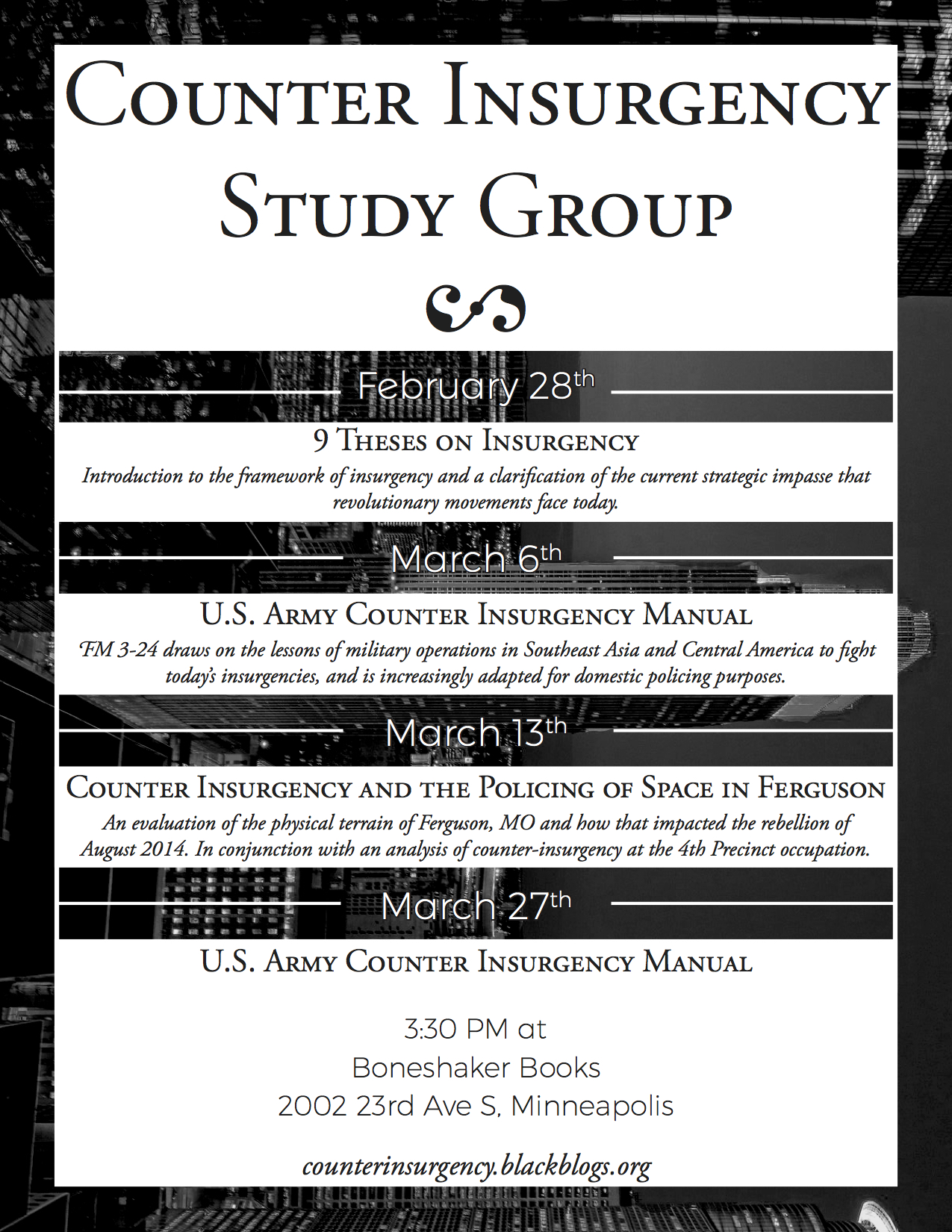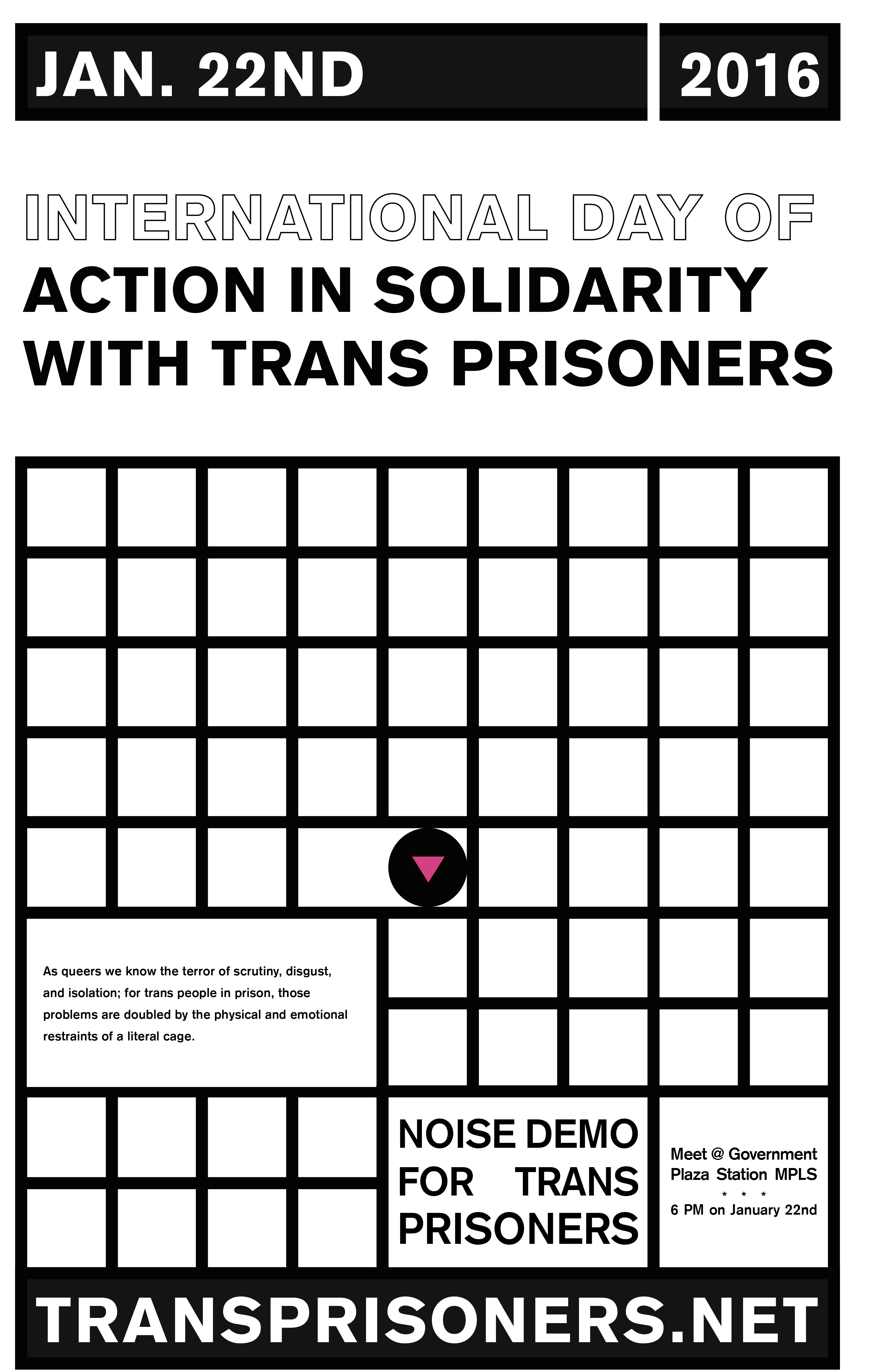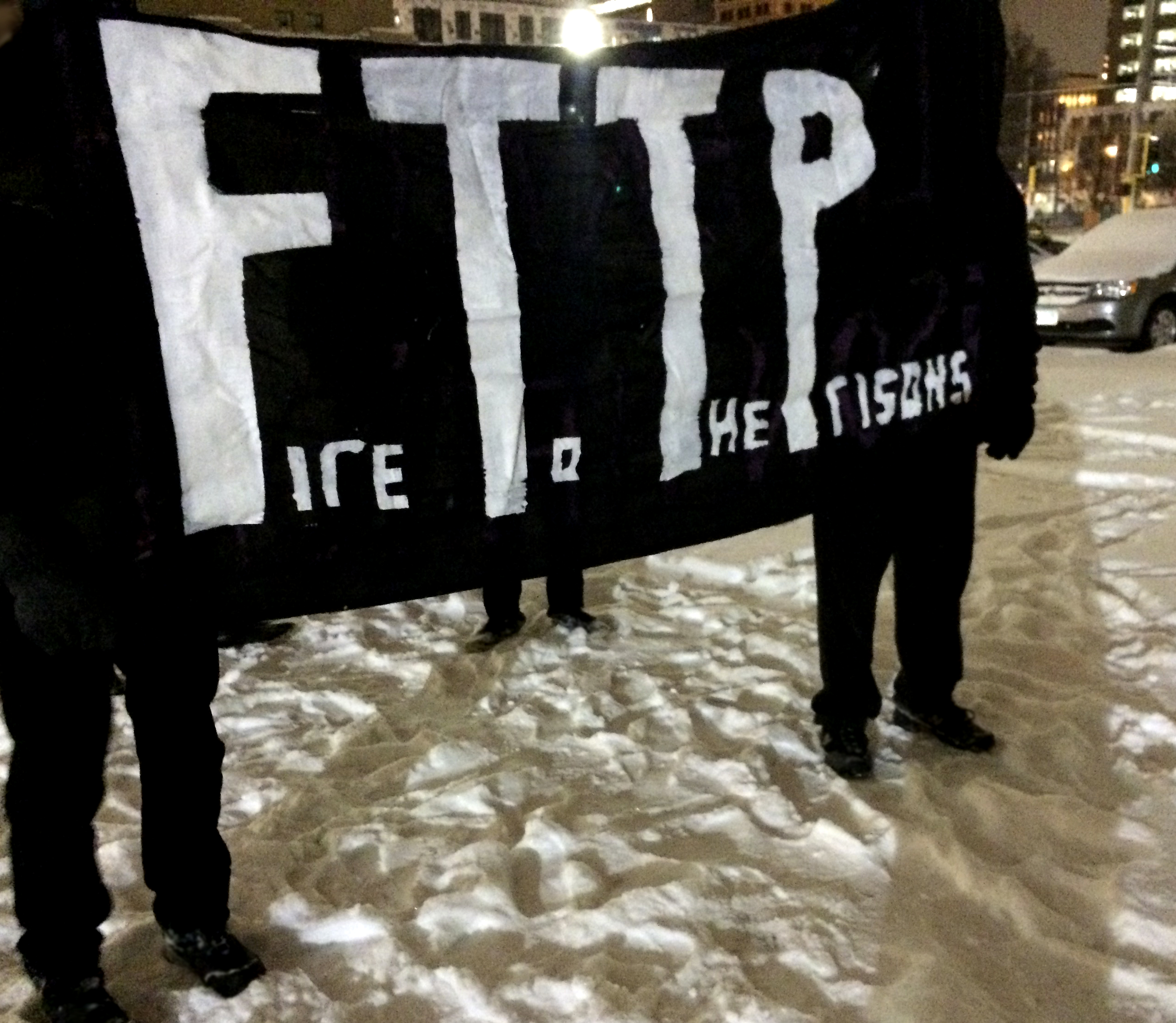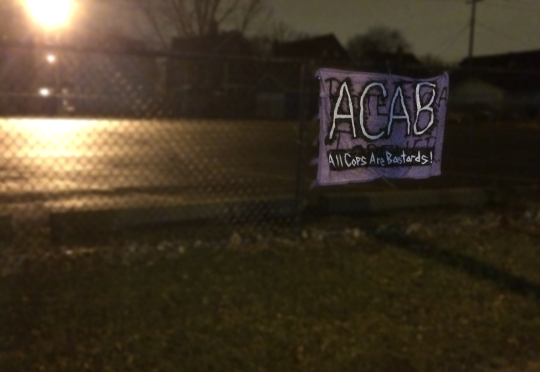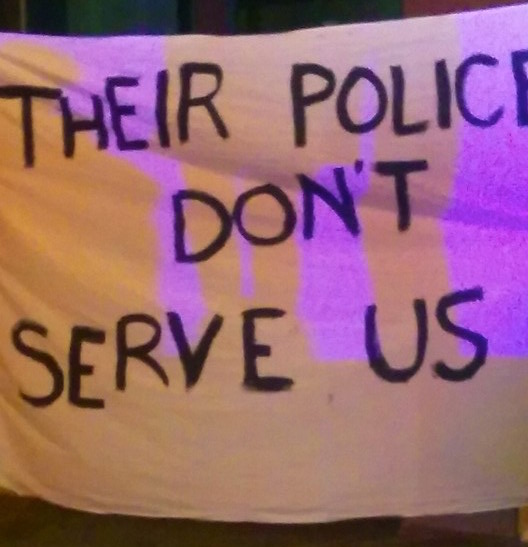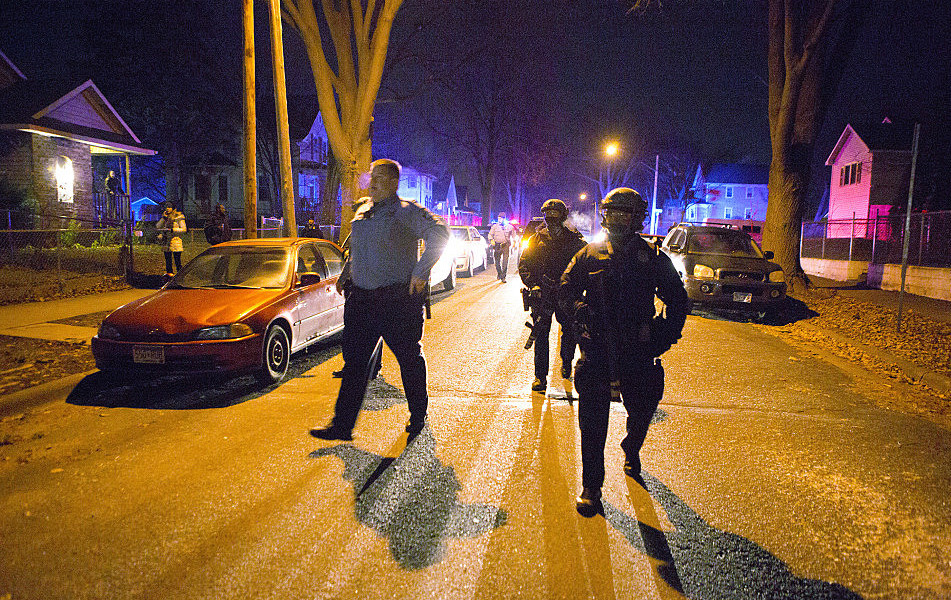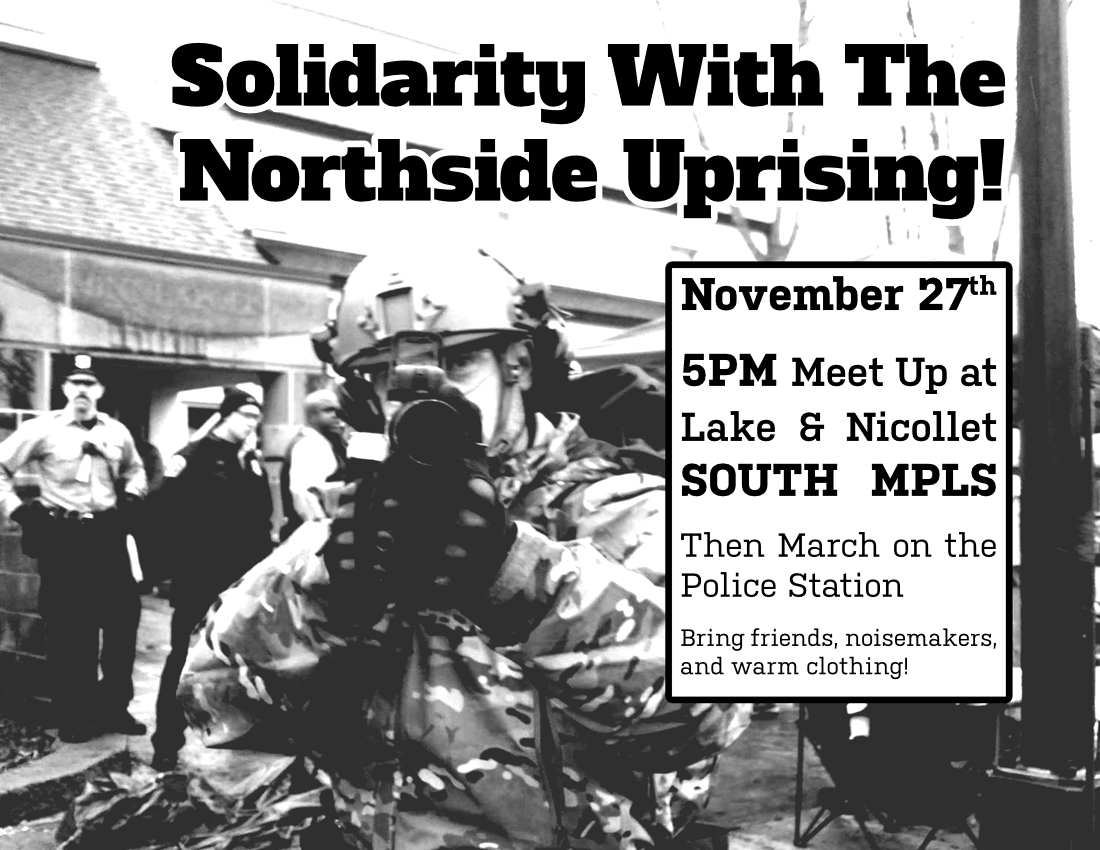Anonymous submission to Conflict Minnesota
#JamesAndPlymouth, then #Justice4Jamar, have joined the numerous hashtags that spread across the globe in response to yet another police shooting. James & Plymouth references the intersection by which Jamar Clark was shot in the head by the police, which occurred while he was handcuffed according to witnesses.
The shooting took place on Plymouth Ave in North Minneapolis, a predominantly black neighborhood of the city. In 1967, Plymouth Ave was the scene of a so-called race riot, where black insurgents battled police for multiple nights as they looted and burned stores. In 2002, another police shooting set off a riot in North Minneapolis when residents attacked police and burned media vehicles at the scene. Earlier this year it was designated as a federal “promise zone” which is aimed at spurring economic development, one of eleven in the country. Also on this list is St. Louis County.
November 15th
After a press conference from the NAACP, people gathered at the intersection of James & Plymouth for a march. Several activists were speaking in front of the crowd and media. Before long, people held hands and stood blocking the street on both ends of the block. This was declared to be a “no cop zone,” although only symbolically. After some chanting, we started marching west toward the nearby MPD precinct. Once there, again speakers addressed the crowd. At one point, a brick was hurled at the building.
As the sun set, people discussed what to do next. Some were very adamant about marching to some event nearby where the Mayor and Police Chief would be. Others intended to stay at the precinct, supposedly to pressure the officers inside to do something. Both occurred, some marched to the Mayor while the rest set up a makeshift camp in the vestibule of the precinct. Late into the night, a side entrance to the building was also blocked while people threw bottles at police and sabotaged their vehicles.
 Throughout these actions, organizers make fairly constant reference to their actions as being done by “the community.” However, even putting aside the myth of the community, there is an important distinction between the people who live in the neighborhood where these actions have taken place and the people participating in many of the actions. Using the language of “the community” erases this distinction. Many people who ostensibly lived in the area were unhappy with the arrival of the activists groups on their block. On the first day alone, residents interrupted the rally several times, telling off the activists who show up for the cameras. This dynamic continued in the next days.
Throughout these actions, organizers make fairly constant reference to their actions as being done by “the community.” However, even putting aside the myth of the community, there is an important distinction between the people who live in the neighborhood where these actions have taken place and the people participating in many of the actions. Using the language of “the community” erases this distinction. Many people who ostensibly lived in the area were unhappy with the arrival of the activists groups on their block. On the first day alone, residents interrupted the rally several times, telling off the activists who show up for the cameras. This dynamic continued in the next days.
November 16th
To the surprise of many, those camped in the precinct’s vestibule were not arrested or evicted by the police. In fact, the occupation grew, with tents and a fire pit sprouting up throughout the day. It began to take on a familiar “Occupy” atmosphere.
In the evening, people once again marched, this time to the freeway. 94W was blocked for over an hour, as police facilitated drivers stuck in traffic onto the closest exit. One driver plowed through the crowd, which resulted in a short brawl between angry protesters and the police trying to protect the vehicle. Eventually the police gave a final warning to those blocking the freeway and those not comfortable with offering themselves up for arrest left. A spontaneous march then took place, back to the occupied precinct.
 Even given the impromptu and unorganized nature of the late march, Black Lives Matter marshals remained in control. Directing traffic, regulating how many lanes we were allowed to take up; ensuring everyone’s safety, as they might put it. These protest marshals have been a constant feature of actions put on by Black Lives Matter and other affiliated organizations, and most of the time can be recognized by their yellow vests. As the Conflict MN blog has pointed out already, these marshals act as an extension of the police, even if they don’t quite realize it.
Even given the impromptu and unorganized nature of the late march, Black Lives Matter marshals remained in control. Directing traffic, regulating how many lanes we were allowed to take up; ensuring everyone’s safety, as they might put it. These protest marshals have been a constant feature of actions put on by Black Lives Matter and other affiliated organizations, and most of the time can be recognized by their yellow vests. As the Conflict MN blog has pointed out already, these marshals act as an extension of the police, even if they don’t quite realize it.
So in this way, these activist groups are policing the neighborhood in a way that the uniformed cops were unable to do. By initiating all calls for action, they can also contain the actions. Without them, the police would have to deal with the unpredictable activity of those angered by the shooting, and have nothing but brute force to handle it.
Late into the night, Jamar Clark was taken off of life-support, and announced dead.
November 17th
Anticipating potential anger over the announcement of Jamar’s death, Black Lives Matter called for “healing spaces” at the precinct on Tuesday night
November 18th
Early in the afternoon,a SWAT team raided the occupation of the MPD precinct’s vestibule. For the next several hours, the occupiers and their supporters rallied in front of the station that was now blocked off by police. The scandal, according to many activists, was that this raid took place while the Mayor was meeting with the so-called “leaders” of the protest. The problem here is twofold: we must not negotiate in any way with those in power, and we must not put anyone in a leadership position to do so. There should be no interest in meeting with the Mayor, nor should the absence of select individuals be debilitating to an action.
People began to surround the building and blockade all entrances the precinct. As the night progressed, police attempted to regain ground by making sudden charges only to retreat just as quickly. These maneuvers often included mace and marker rounds, and prompted objects to be thrown from the crowd, although just as many felt obligated to deride their fellow demonstrators with chants of “peaceful protest.” Large tarps were fixed to the fences at the side entrances in order to block the view of the police as well as impede their less lethal weapons.
It’s notable that the building has not always housed the MPD precinct. This would explain it’s vulnerabilities, the relative ease with which the station was occupied and blockaded. One side of the precinct did not even have a single surveillance camera, which was made up for by a mobile camera tower erected earlier during the occupation. This camera was eventually toppled and used to barricade the closest entrance.
This seemed to provoke more marker rounds being fired at the crowd, which was met in turn with more bottles and rocks. Pleas for peace went ignored as bricks were broken up and hurled over the fence at the cops. A dumpster from the alley was dragged out but too wet from the rain to ignite. The street fighting continued over an hour, as people threw bricks while ducking behind cars to dodge the rounds fired by the police. As the crowd thinned out, multiple molotov cocktails were launched at the cops.
Very quickly, many activists laid the blame on “white anarchists” for the violence, something the police picked up on the next day. This denies the fact that many people who fought the police were black, and whose political affiliations could not easily be determined. Most militants appeared to be from the neighborhood, unlike the activists telling them what is or isn’t acceptable forms of resistance.
November 19th
The occupation of the precinct’s lawn continued to grow, with a couple hundred gathering in response to Black Lives Matter’s call for a mass occupation in the evening. People gathered around fire-pits, handed out donated pizzas, as well as warm clothing. As tempting as it would be to call it an autonomous space, the reality was that even with the boys in blue idling behind the barricades, it was still densely policed by activists and the abundance of cameras. Several elected officials were invited and spoke to the crowd, hoping to soothe any rebellious tensions.
They were not entirely successful, as the precinct was decorated by multiple graffiti writers. The police responded by shooting more marker rounds into the occupation. Two men were later arrested, accused of being the vandals (more info to come on legal support.)
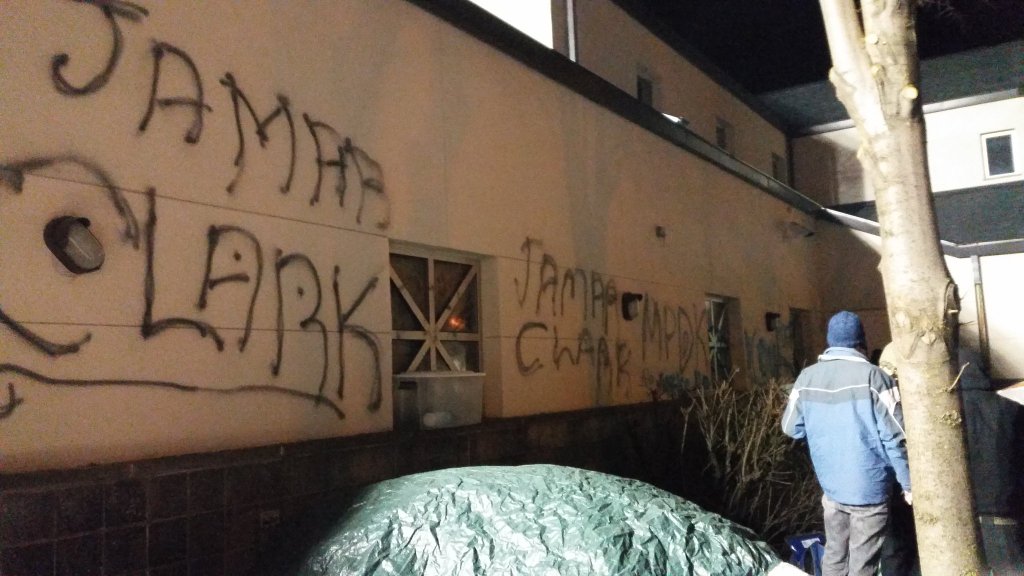 As the activist groups struggle to regain control of the movement, it’s clear that their legitimacy has been irreparably damaged in the eyes of those interested in fighting against the systems of oppression. Nothing is over.
As the activist groups struggle to regain control of the movement, it’s clear that their legitimacy has been irreparably damaged in the eyes of those interested in fighting against the systems of oppression. Nothing is over.
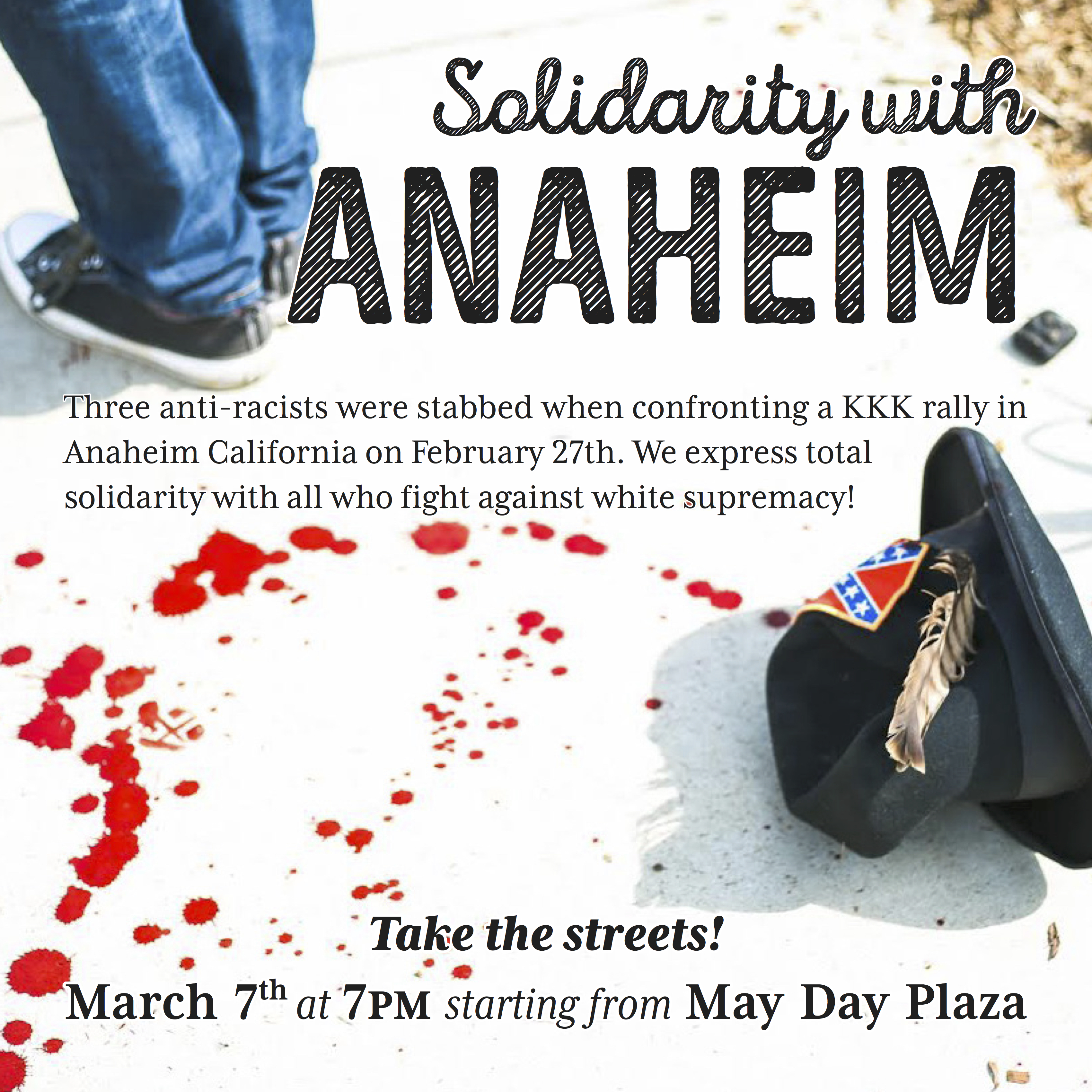 Saturday, February 27th, a KKK rally was confronted in Anaheim, California. Fighting quickly broke out and left three anti-racists stabbed. In Minneapolis we are very familiar with this escalating white supremacist violence, and express total solidarity with those who stood up to the Klan.
Saturday, February 27th, a KKK rally was confronted in Anaheim, California. Fighting quickly broke out and left three anti-racists stabbed. In Minneapolis we are very familiar with this escalating white supremacist violence, and express total solidarity with those who stood up to the Klan.

